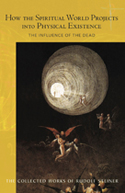
-
HOW THE SPIRITUAL WORLD PROJECTS INTO PHYSICAL EXISTENCE
The Influence of the Dead
Rudolf Steiner

‘By cultivating spiritual thoughts here on earth we can provide nourishment for the dead... When fields lie fallow they produce no crops to feed humanity and people may die of starvation. The dead cannot die of starvation, of course; all they can do is suffer when spiritual life lies fallow on earth.’ – Rudolf Steiner
The founding of the Anthroposophical Society in 1913 marked a major change in Rudolf Steiner’s work. Although Steiner had always been an independent spiritual researcher, the break with the theosophists removed all constraints, allowing for a full flowering of anthroposophy. These lectures, presented to audiences in Germany, France and Sweden, are filled with a freshness and vitality that reflect this new beginning, providing intriguing glimpses of great themes that Steiner was to develop in the years ahead.
A predominant topic here is that of death. Rudolf Steiner seeks to explain how people on earth can reach the dead in a non-mediumistic way, and how such interaction between ‘living’ and ‘dead’ is mutually beneficial. Startlingly, he states that people who do not recognize the being of Lucifer during their earthly life – who have not ‘already got to intuit and know the luciferic impulses in the human soul properly whilst here in life’ – will be ‘vampirized’ by this being after death. Rudolf Steiner also elaborates on the activities of the adversary beings in present-day civilization – spiritual powers that play a necessary role in Earth evolution – and how we can counteract them. The longer someone can stay alive, for example, is a victory over Ahriman’s activity. Even the losing of teeth has beneficial aspects, allowing us to ‘... gain certain impulses and these overcome Ahriman’. Steiner relates the actions of such spiritual entities to child development too, indicating the various influences in the seven-year cycles of growth.
Also included are lectures on the Christian festivals and various artworks, including ‘The Triumph of Death’ in the Composanto cemetery at Pisa, which reveals great secrets of humanity’s evolution. Whatever the subject addressed, it soon becomes apparent that these lectures were not just relevant to Steiner’s audience in 1913, but also speak to contemporary souls around the world seeking spiritual orientation and understanding.
3 November 2014; Trans. A. Meuss (10 lectures, various cities, Jan.–Dec. 1913, CW 150); RSP; 160pp; 23.5 x 15.5 cm; pb;
£14.99 ISBN 9781855844049

